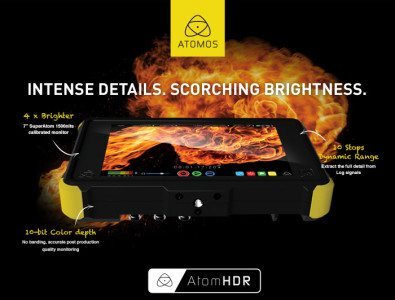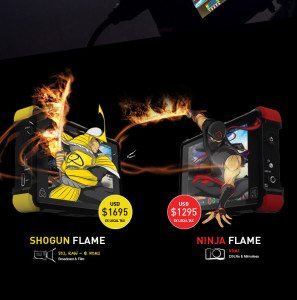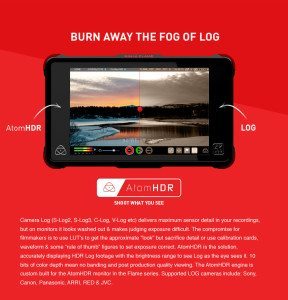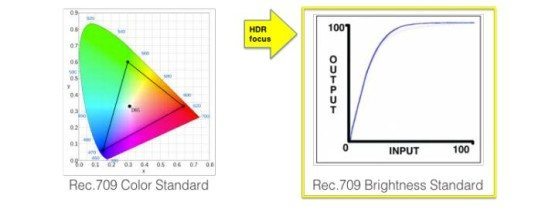Atomos has done it again. My favorite external recorder has delivered the perfect tool for HDR recording, the Shogun Flame and the Ninja Flame.
With price points that you can live with of $1695 for the Shogun Flame and $1295 for the Ninja Flame
. Here is how it all works.
HDR Tech-Guide
Visible light is most often the defining factor in the images we create and can have the largest influence on the end results. Since the advent of CRT and the progression through the early generation of LCD we’ve been confined to the limitations of CRT that defined both the color space and brightness levels for what we now typically refer to as REC.709 The maximum capability of a CRT was classified at 100% input, representing 6-7 Stops (each stop represents a doubling of luminance) of dynamic range or brightness range
These shackles on both color and dynamic range capabilities have long been surpassed by camera imaging technology, which has moved on displaying upward of 14 stops of dynamic range. Displaying this on Rec709 monitors however with only 6 stops of dynamic range means you have to choose where you lose the detail. Retain detail in the dark areas and crush the whites or vice versa. Rec709 has been the standard “clip and display” method. Like MPEG long GOP compression, interlaced images and 4:2:0 color compression, Rec.709 is an outdated standard that curtails our creative abilities. The solution for camera operators has been using Log curves to “bend” and fit the extra detail into 10-bit or Log curves with 10 stops. The challenge is that now by redistributing the recording levels to fit inside the Rec709 standard most of the brightness in an image has been “compressed” and the scene ends up looking “washed out” and unnatural leaving the operator to “judge” exposure using a combination of LUTs, exposure charts for 18% middle grey and 90% white that can not only be time-consuming but also a technical stumbling point for many. This is where the AtomHDR engine provides a revolutionary step in on set monitoring delivering the extremes of brightness with the 1500nit screen, over 10 stops of dynamic range with the AtomHDR engine and smooth color transitions with the new 10-bit panel.
These shackles on both color and dynamic range capabilities have long been surpassed by camera imaging technology, which has moved on displaying upward of 14 stops of dynamic range. Displaying this on Rec709 monitors however with only 6 stops of dynamic range means you have to choose where you lose the detail. Retain detail in the dark areas and crush the whites or vice versa. Rec709 has been the standard “clip and display” method. Like MPEG long GOP compression, interlaced images and 4:2:0 color compression, Rec.709 is an outdated standard that curtails our creative abilities. The solution for camera operators has been using Log curves to “bend” and fit the extra detail into 10-bit or Log curves with 10 stops. The challenge is that now by redistributing the recording levels to fit inside the Rec709 standard most of the brightness in an image has been “compressed” and the scene ends up looking “washed out” and unnatural leaving the operator to “judge” exposure using a combination of LUTs, exposure charts for 18% middle grey and 90% white that can not only be time-consuming but also a technical stumbling point for many. This is where the AtomHDR engine provides a revolutionary step in on set monitoring delivering the extremes of brightness with the 1500nit screen, over 10 stops of dynamic range with the AtomHDR engine and smooth color transitions with the new 10-bit panel.
The maximum capability of a CRT was classified at 100% input, representing 6-7 Stops (each stop represents a doubling of luminance) of dynamic range or brightness range Stops (DR) 1 Stop 2 Stop 3 Stop 4 Stop 5 Stop 6 Stop Rec. 709 7 Stop 8 Stop 9 Stop 10 Stop Atom HDR 11 Stop Input 21 = 2 22 = 4 23 = 8 24 = 16 25 = 32 26 = 64 27 = 128 28 = 256 29 = 512 210 = 1024 211 = 2048 These shackles on both color and dynamic range capabilities have long been surpassed by camera imaging technology, which has moved on displaying upward of 14 stops of dynamic range.
Displaying this on Rec709 monitors however with only 6 stops of dynamic range means you have to choose where you lose the detail. Retain detail in the dark areas and crush the whites or vice versa. Rec709 has been the standard “clip and display” method. Like MPEG long GOP compression, interlaced images and 4:2:0 color compression, Rec.709 is an outdated standard that curtails our creative abilities. The solution for camera operators has been using Log curves to “bend” and fit the extra detail into 10-bit or Log curves with 10 stops. The challenge is that now by redistributing the recording levels to fit inside the Rec709 standard most of the brightness in an image has been “compressed” and the scene ends up looking “washed out” and unnatural leaving the operator to “judge” exposure using a combination of LUTs, exposure charts for 18% middle grey and 90% white that can not only be time consuming but also a technical stumbling point for many. This is where the AtomHDR engine provides a revolutionary step in on set monitoring delivering the extremes of brightness with the 1500nit screen, over 10 stops of dynamic range with the AtomHDR engine and smooth color transitions with the new 10-bit panel.






